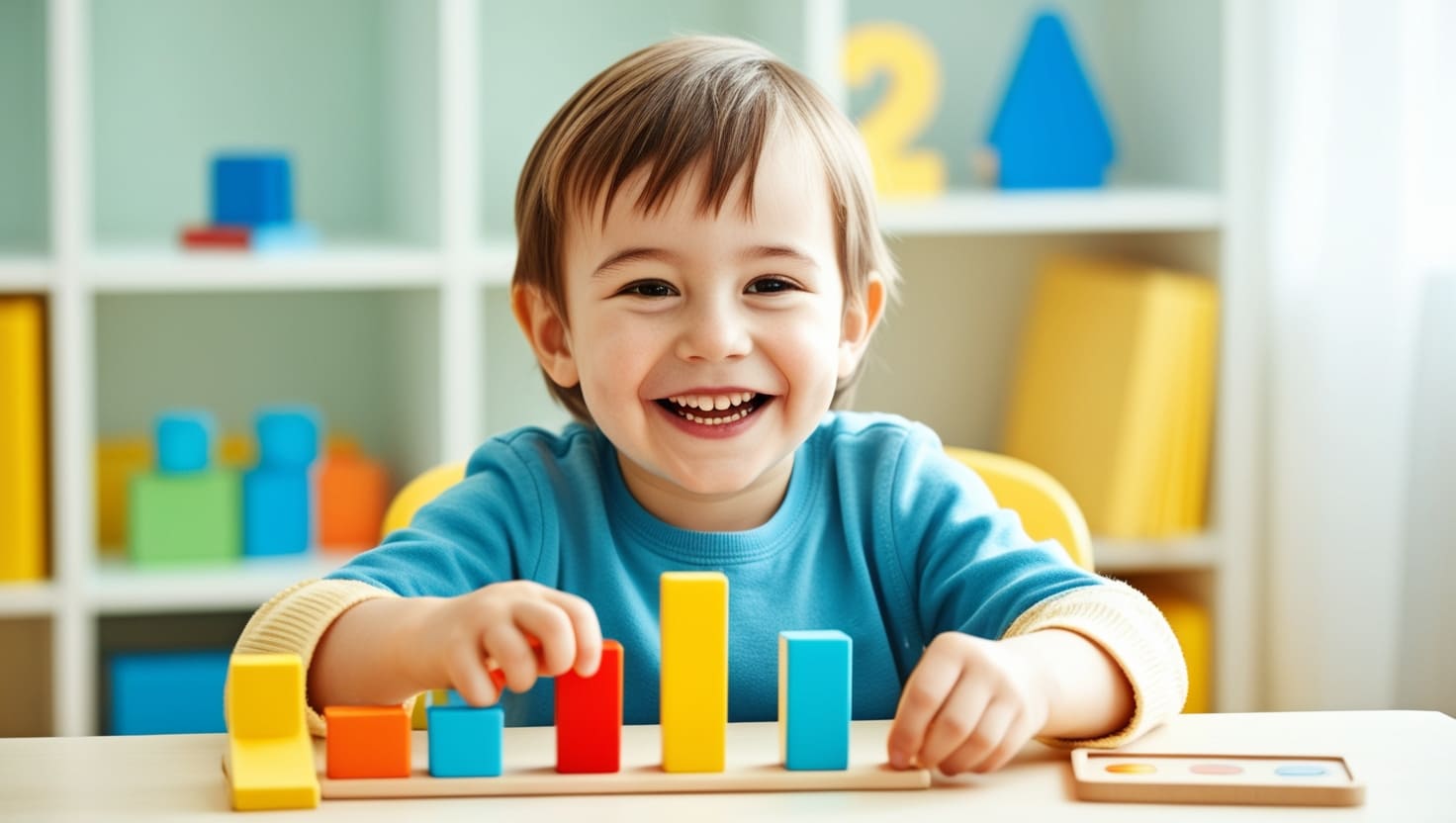المدونة
كيفية جعل الرياضيات ممتعة لطفلك

هل يعتقد طفلك أن الرياضيات مملة أو صعبة؟ لست وحدك! كثير من الأطفال يشعرون بنفس الشعور، ولكن الخبر السار هو أن الرياضيات ليست بالضرورة صعبة. بل يمكن أن تكون جزءًا ممتعًا ومثيرًا من حياتهم اليومية. عندما يجد الأطفال متعة في الرياضيات، يصبحون أكثر ثقةً وفضولًا وانفتاحًا على استكشاف الأرقام والأنماط وحل المشكلات.
في هذه المقالة، سنشارك طرقًا إبداعية وجذابة لجعل الرياضيات ممتعة لطفلك. من الألعاب التفاعلية إلى الأنشطة العملية، يمكن للرياضيات أن تنبض بالحياة بطرق تجعل التعلم ممتعًا. لنستكشف معًا كيف يمكنك تحويل الرياضيات إلى مغامرة ممتعة!
النصيحة رقم ١: حوّل الرياضيات إلى لعبة
من أفضل الطرق لجعل الرياضيات ممتعة هي تحويلها إلى لعبة. فالألعاب تفاعلية بطبيعتها، وتجعل التعلم أشبه باللعب وليس مجرد مهمة. سواء كنت تستخدم البطاقات أو النرد أو ألعاب الطاولة البسيطة، يمكنك تقديم المفاهيم الرياضية بطريقة مرحة وتفاعلية.
- استخدم النرد أو البطاقات أو ألعاب الطاولة: يمكن استخدام العديد من الألعاب الكلاسيكية لتعليم الرياضيات. على سبيل المثال، يمكنك لعب ألعاب رياضيات بسيطة تتضمن العد أو الجمع أو مطابقة الأرقام باستخدام النرد أو البطاقات. ألعاب مثل بنغو الرياضيات أو مطابقة الأرقام مثالية لتعزيز مفاهيم الرياضيات مع الاستمتاع.
- ابتكر تحديات رياضية بنفسك: لعبة البحث عن الكنز في الرياضيات المصنوعة منزليًا طريقة رائعة لتحفيز الأطفال على التفكير والحركة. خبئ أرقامًا أو أشياءً في المنزل واطلب من طفلك حل مسائل رياضية للعثور على كل منها. يمكنك أيضًا تشغيل نسخة رياضية من لعبة "سايمون يقول"، حيث يتعين على الأطفال حل المسائل قبل تنفيذ الأمر التالي.
- استخدم التكنولوجيا بحكمة: هناك العديد من التطبيقات المناسبة لأعمار الأطفال والتي تساعدهم على ممارسة مهارات الرياضيات من خلال ألعاب ممتعة. تذكر فقط الموازنة بين وقت استخدام الشاشة واللعب التفاعلي للحصول على أفضل تجربة تعليمية.
من خلال تحويل الرياضيات إلى لعبة، فإنك لا تبقي طفلك منخرطًا فحسب، بل تجعل عملية التعلم تبدو طبيعية وممتعة أيضًا.
النصيحة رقم ٢: استخدم الرياضيات الواقعية يوميًا
الرياضيات ليست مجرد مادة نتعلمها في المدرسة، بل هي جزء لا يتجزأ من أنشطتنا اليومية. بدمج الرياضيات في مواقفنا اليومية، تساعد طفلك على إدراك مدى فائدة الرياضيات ومتعتها.
- الطبخ معًا: عندما تطبخ، فأنت تستخدم الرياضيات دون أن تدرك ذلك! دع طفلك يساعدك في قياس المكونات، أو عدّ المغارف، أو مضاعفة الوصفة. هذه فرص رائعة لممارسة الأرقام والكسور والجمع الأساسي. كما أنها طريقة رائعة لتوطيد علاقتك به وتطوير مهاراته في حل المشكلات.
- ممارسة التسوق: سواء كنت في متجر البقالة أو تطلب من قائمة الطعام، هناك طرق عديدة لإدخال الرياضيات في التسوق. اطلب من طفلك عدّ الفواكه أو مقارنة أسعار المنتجات المختلفة. يمكنك أيضًا التدرب على عمليات الجمع أو الطرح البسيطة عن طريق جمع الأسعار أو حساب المبلغ الذي تحتاجه للشراء.
- البناء والقياس: استخدم مكعبات البناء، أو أشرطة القياس، أو المساطر لتعليم طفلك الأطوال والأشكال والهندسة الأساسية. سواءً كان يبني برجًا أو يقيس طول لعبته المفضلة، فإنه يتعلم مهارات رياضية قيّمة ويستمتع بوقته.
إن دمج الرياضيات في الأنشطة اليومية يُظهر لطفلك أن الرياضيات ليست مجرد مادة دراسية؛ بل هي أداة يمكنه استخدامها كل يوم.
النصيحة رقم ٣: استخدم القصص والشخصيات
ليس بالضرورة أن تقتصر الرياضيات على أرقام مكتوبة، بل يمكن أن تنبض بالحياة من خلال القصص والشخصيات. يساعد سرد القصص الأطفال على التواصل عاطفيًا مع المادة، مما يجعلها أكثر رسوخًا في الذاكرة وتفاعلًا معها.
- اقرأ كتبًا تتناول موضوع الرياضيات: تُدرّس العديد من كتب الأطفال مفاهيم الرياضيات بطريقة ممتعة وجذابة. تُعرّف كتب مثل "عشر نقاط سوداء" أو "رنّ جرس الباب" الأطفال على الرياضيات من خلال القصص والرسوم التوضيحية. تُتيح هذه الكتب فرصة رائعة لمناقشة مفاهيم الرياضيات الأساسية مثل العد والجمع والمشاركة.
- ابتكر مغامرات رياضية: ابتكر قصصًا رياضية خاصة بك يكون طفلك بطلها. على سبيل المثال، احكي لطفلك قصةً يتوجب عليه فيها حل مسائل رياضية لإنقاذ شخصية أو العثور على كنز مخفي. هذا يُساعد الأطفال على فهم الرياضيات كأداة لحل المشكلات وابتكار الحلول.
- دمى أو ألعاب الرياضيات: استخدم ألعاب طفلك أو دمىه المفضلة لتمثيل سيناريوهات الرياضيات. يمكنك إنشاء مشهد تتطلب فيه الألعاب عدّ الأشياء أو مشاركة العناصر بالتساوي، مما يساعد طفلك على ممارسة الرياضيات بطريقة ممتعة وخيالية.
تضفي رواية القصص والشخصيات لمسة خيالية على الرياضيات تجذب انتباه طفلك وتجعل التعلم أشبه بالمغامرة.
النصيحة رقم ٤: احتفل بالأخطاء والفضول
قد تُشكّل الرياضيات مصدر قلق للأطفال، خاصةً عندما يخشون من الإجابة بشكل خاطئ. من المهم توفير مساحة آمنة يُحتفى فيها بالأخطاء كجزء من عملية التعلم. هذا يُساعد طفلك على الشعور براحة أكبر وانفتاح أكبر على تجربة أشياء جديدة.
- العب مع الأنماط والتقدير: دع طفلك يُخمّن ويختبرها. اطرح أسئلة مثل: "كم تتوقع عدد الكعكات في البرطمان؟" أو "ماذا تتوقع أن يحدث إذا جمعنا هذين الرقمين؟". دعه يجرب الأنماط والتقدير، وتحدث معه عن أهمية الرياضيات في التنبؤ والاكتشاف.
- Play with Patterns and Estimation: Let your child make guesses and test them. Ask questions like, “How many cookies do you think are in the jar?” or “What do you think will happen if we add these two numbers?” Let them experiment with patterns and estimation, and talk about how math is a way of predicting and discovering.
- اطرح أسئلة مفتوحة: بدلًا من تصحيح الأخطاء بسرعة، اطلب من طفلك شرح طريقة تفكيره. أسئلة مثل "كيف حصلت على هذه الإجابة؟" تساعده على التفكير النقدي وتطوير مهارات حل المشكلات، حتى لو أخطأ.
من خلال الاحتفال بالأخطاء والفضول، يمكنك إنشاء بيئة تعليمية يشعر فيها طفلك بالأمان لاستكشاف مهاراته في الرياضيات وتنميتها.
النصيحة رقم ٥: اجعل الرياضيات عملية ومرئية
يتعلم الأطفال بشكل أفضل عندما يتمكنون من رؤية ولمس ما يتعلمونه. الأنشطة البصرية العملية تجعل مفاهيم الرياضيات المجردة أكثر واقعية ومتعة.
- استخدم الأدوات اليدوية: الأزرار، والمكعبات، والخرز، أو غيرها من الأشياء الصغيرة رائعة لتعليم العد والفرز والعمليات البسيطة. دع طفلك يستخدم هذه الأشياء لحل المسائل بشكل ملموس، مما يساعد على إدراك مفهوم الأرقام والكميات.
- أبدع فنون الرياضيات: الرياضيات والفنون تتكاملان! استخدم الأشكال والأنماط والتناظر في الأعمال اليدوية. على سبيل المثال، أنشئ "ملصقة أرقام" أو اجعل طفلك يرسم تصاميم متناظرة. هذا يساعد الأطفال على فهم المفاهيم الهندسية بطريقة إبداعية.
- ارسمها: في بعض الأحيان، يمكن أن يساعد رسم صورة أو رسم تخطيطي في تسهيل فهم المسائل الرياضية. استخدم خطوط الأعداد أو الرسوم البيانية الشريطية أو الرسومات البسيطة لتصور المسائل الرياضية. وهذا يساعد الأطفال على إقامة روابط بين الأرقام ومواقف العالم الحقيقي.
تعمل الأنشطة العملية والبصرية على إشراك العديد من الحواس، مما يجعل تعلم الرياضيات أكثر متعة وفعالية.
إن جعل الرياضيات ممتعة لا يتطلب بالضرورة أدواتٍ معقدة أو دروسًا معقدة. بقليل من الإبداع والتشجيع والصبر، يمكنكِ تحويل الرياضيات إلى جزءٍ ممتعٍ ومثيرٍ من حياة طفلكِ اليومية. من خلال الألعاب والأنشطة الواقعية ورواية القصص والمشاريع العملية، سيبدأ طفلكِ برؤية الرياضيات ليس كمهمةٍ روتينية، بل كشيءٍ ممتعٍ ومُحفز.
تذكروا أن الهدف هو جعل الرياضيات ممتعة، والاحتفال بكل خطوة من خطواتها، ومساعدة طفلكم على الشعور بالثقة في قدرته على استكشاف الأرقام والأنماط. مع الوقت والتشجيع، سيبدأ برؤية الرياضيات كشيء يستمتع به وينجح فيه!










